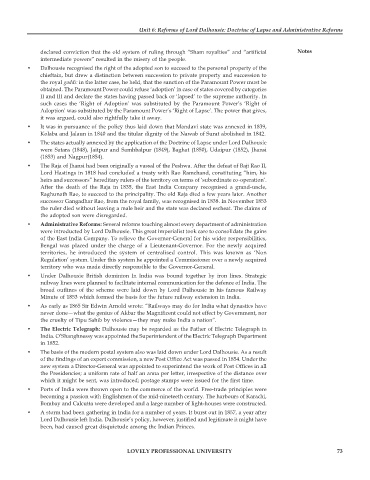Page 78 - DHIS204_DHIS205_INDIAN_FREEDOM_STRUGGLE_HINDI
P. 78
Unit 6: Reforms of Lord Dalhousie: Doctrine of Lapse and Administrative Reforms
declared conviction that the old system of ruling through “Sham royalties” and “artificial Notes
intermediate powers” resulted in the misery of the people.
• Dalhousie recognised the right of the adopted son to succeed to the personal property of the
chieftain, but drew a distinction between succession to private property and succession to
the royal gaddi: in the latter case, he held, that the sanction of the Paramount Power must be
obtained. The Paramount Power could refuse ‘adoption’ in case of states covered by categories
II and III and declare the states having passed back or ‘lapsed’ to the supreme authority. In
such cases the ‘Right of Adoption’ was substituted by the Paramount Power’s ‘Right of
Adoption’ was substituted by the Paramount Power’s ‘Right of Lapse’. The power that gives,
it was argued, could also rightfully take it away.
• It was in pursuance of the policy thus laid down that Mandavi state was annexed in 1839,
Kolaba and Jalaun in 1840 and the titular dignity of the Nawab of Surat abolished in 1842.
• The states actually annexed by the application of the Doctrine of Lapse under Lord Dalhousie
were Satara (1848), Jaitpur and Samhbalpur (1849), Baghat (1850), Udaipur (1852), Jhansi
(1853) and Nagpur(1854).
• The Raja of Jhansi had been originally a vassal of the Peshwa. After the defeat of Baji Rao II,
Lord Hastings in 1818 had concluded a treaty with Rao Ramchand, constituting “him, his
heirs and successors” hereditary rulers of the territory on terms of ‘subordinate co-operation’.
After the death of the Raja in 1835, the East India Company recognised a grand-uncle,
Raghunath Rao, to succeed to the principality. The old Raja died a few years later. Another
successor Gangadhar Rao, from the royal family, was recognised in 1838. In November 1853
the ruler died without leaving a male heir and the state was declared escheat. The claims of
the adopted son were disregarded.
• Administrative Reforms: Several reforms touching almost every department of administration
were introducted by Lord Dalhousie. This great imperialist took care to consolidate the gains
of the East India Company. To relieve the Governor-General for his wider responsibilities,
Bengal was placed under the charge of a Lieutenant-Governor. For the newly acquired
territories, he introduced the system of centralised control. This was known as ‘Non
Regulation’ system. Under this system he appointed a Commissioner over a newly acquired
territory who was made directly responsible to the Governor-General.
• Under Dalhousie British dominion In India was bound together by iron lines. Strategic
railway lines were planned to facilitate internal communication for the defence of India. The
broad outlines of the scheme were laid down by Lord Dalhousie in his famous Railway
Minute of 1853 which formed the basis for the future railway extension in India.
• As early as 1865 Sir Edwin Arnold wrote: “Railways may do for India what dynasties have
never done—what the genius of Akbar the Magnificent could not effect by Government, nor
the cruelty of Tipu Sahib by violence—they may make India a nation”.
• The Electric Telegraph: Dalhousie may be regarded as the Father of Electric Telegraph in
India. O’Shanghnessy was appointed the Superintendent of the Electric Telegraph Department
in 1852.
• The basis of the modern postal system also was laid down under Lord Dalhousie. As a result
of the findings of an expert commission, a new Post Office Act was passed in 1854. Under the
new system a Director-General was appointed to superintend the work of Post Offices in all
the Presidencies; a uniform rate of half an anna per letter, irrespective of the distance over
which it might be sent, was introduced; postage stamps were issued for the first time.
• Ports of India were thrown open to the commerce of the world. Free-trade principles were
becoming a passion with Englishmen of the mid-nineteeth century. The harbours of Karachi,
Bombay and Calcutta were developed and a large number of light-houses were constructed.
• A storm had been gathering in India for a number of years. It burst out in 1857, a year after
Lord Dalhousie left India. Dalhousie’s policy, however, justified and legitimate it might have
been, had caused great disquietude among the Indian Princes.
LOVELY PROFESSIONAL UNIVERSITY 73

